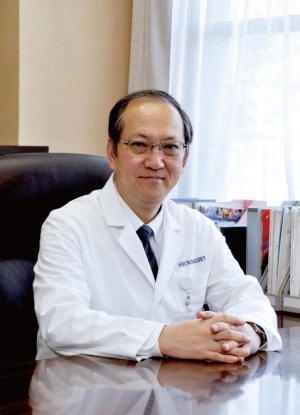Top > About Us > News Letter > Aiming for further advancement
Aiming for further advancement of healthcare and enhancement of hospital structure
New Director Nobuhito Saito, M.D., Ph.D.

I have felt greatly challenged and responsible for my new work since my appointment as the director of this hospital. It is my duty to think and plan research and education as well as medical services from a long-term perspective stretching in to the next decade. Recently, compliance with clinical research ethics became a social concern. For this issue, in particular, we have prioritized our activity to establish the “Clinical Research Governance Department” and other procedures; however, I believe that continuous improvement is required for these issues, including medical ethics. In addition, there is an enormous number of issues, including a sales tax increase, aging, and promoting internationalization.
In my specialty, neurosurgery, I have been trained as a physician providing advanced healthcare and have been educating young physicians. From this experience, I realized that knowledge is more important than skills. If we compare surgery to a path, “skills,” such as a somersault or twist, are not required when you are walking on the path, and it is important to move steadily forward while predicting and avoiding pitfalls or mud. You must always realize that skills are based on knowledge.
The University of Tokyo Hospital is currently in a developmental stage. It is represented by a series of the construction of both clinical service and clinical research buildings, which will continue until FY2018. “Phase I construction of Clinical Research Bldg. A” will be completed in October 2015, followed by the completion of other research facilities, including “Molecular & Life Innovation Build.(MLI),” “Phase II of Clinical Research Bldg. A,” and “Clinical Research Bldg. B.” We also have a perfect plan to develop the appropriate “contents” for each building based on our “University of Tokyo Medical Town” and “Center of Innovation for Academia” schemes. I expect that new facilities will further activate research and become an innovation center that contributes to society by identifying the causes of diseases and discovering novel treatments.
“Phase II construction of Inpatient Bldg. (which will be named “Inpatient Bldg. B” upon its completion),” a clinical service building, will be completed in 2017. We plan to strengthen functions based on basic concepts of enhancement of high-functional beds and perinatal and pediatric care. In this building, as well as in the existing Inpatient Bldg. A, we continue to provide treatment for patients with severe and intractable diseases by enhancing the quality of highly advanced healthcare services that are specifically provided only in our hospital.
A foundation of “highly advanced healthcare” is “to provide medical care in partnership with the patients” and “to provide safe medical care,” both of which are of the utmost priority in our hospital. The most basic activity of our staff is to always make eye contact with patients and listen to them. To practice this, communication between staff members is also essential. We must keep in mind the importance of communication because our hospital is large. I believe that all our patients can receive treatment while feeling comfortable in our hospital where compassion and hospitality are highly valued.
